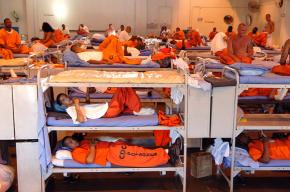The policy that keeps on failing
, national director of the Campaign to End the Death Penalty, looks at a study that exposes the consequences of the politicians' "tough on crime" hysteria.
ONE IN every 31 adults in the U.S. is in prison or jail or on parole or probation. That's 7.3 million people--or more than the populations of Chicago, Philadelphia, San Diego and Dallas put together.
These statistics--from a study released by the Pew Center on the States titled "One in 31: The Long Reach of American Corrections"--are the consequence of this country's 30 years of tough-on-crime policies.
Not surprisingly, the "long reach" doesn't reach everybody evenly--African Americans suffer the brunt of the system. According to Pew study, one in 11 African American adults are under the control of the corrections system, compared with one in 27 Latinos and one in 45 whites. Southern states continue to have the highest incarceration rates.
And while the U.S. incarcerates its population in staggering numbers compared to other industrialized countries, its crime rates aren't lower. On the contrary, they are higher, especially violent crime rates.
The astronomical growth in incarceration began in the 1970s and has continued to the present day, largely as a result of "tough on crime" policies implemented by political leaders who found this appeal to be helpful in winning elections. As the social movements of the 1960s and early 1970s faded, this rhetoric took hold and was manifested in policies that required stiffer and longer sentences for any crime.

One aspect was the "war on drugs," which imposed harsh punishments on nonviolent drug offenders. According to an article in the New England Journal of Medicine, by 1994, the drug war was responsible for sending 1 million Americans to prison every year.
Meanwhile, harsh sentencing policies took their toll. California introduced a "three strikes and you're out" law, which required that anyone convicted of any third felony, no matter how petty, be sentenced to 25 years to life sentence--the policy quickly spread to other states. Federal parole was eliminated in the 1980s, and most states passed mandatory minimum sentencing laws, making it impossible for judges to impose a lighter sentence or divert someone into treatment rather than prison.
These are the reasons why the U.S. prison population took off--not, as some might imagine, because of an increase in crime. As the Pew study notes:
The explosive prison growth of the past 30 years didn't happen by accident and wasn't driven primarily by crime rates or broad social and economic forces beyond the reach of state government. It was the direct result of sentencing, release and other correctional policies that determine who goes to prison and how long they stay.
THE PEW study also points out that states are paying the price--literally--for these unjust policies.
According to the study, state government spending on corrections outpaced other essential government services, from education to transportation to public assistance--only Medicaid spending grew faster. "States spent a record $51.7 billion on corrections in 2008, or one in every 15 general fund dollars," the study reports. "Adding local, federal and other funding brings the national correctional spending total to $68 billion."
In studying 34 states, Pew researchers found that it cost 22 times more money per day to incarcerate people than to supervise them in the community--the cost per prisoner is, on average, $29,000 a year. As a result, $9 out of every $10 spent on corrections goes to prisons.
Pressured in part by rapidly increasing budget deficits, some politicians are starting to support diverting money from prisons to community supervision and drug treatment programs for nonviolent property- and drug-related crimes.
Thus, New York's notorious Rockefeller Drug Laws are headed toward reform. Enacted in the 1970s, these laws imposed prison sentences of 10, 15 and 20 years on people found guilty of low-level drug offenses--even if it was their first conviction. A bill to repeal these laws has passed the State Assembly and is under consideration in the Senate.
We certainly need to shift away from the lock-em-up-and-throw-away-the-key approach to dealing with the problems of crime. But it's shortsighted to think this is all we need.
With the economic crisis spreading, and poverty and unemployment on the rise, crime rates can be expected to go up. As the Pew Center researchers point out, this means that resources in the community have to be expanded, not curtailed.
But under the pressure of state budget crises, the opposite is happening. Washington state, for example, is considering cutting half of all beds in drug treatment facilities, and lawmakers in Florida have proposed cutting 3 million people from drug treatment programs.
The real solution to crime isn't the construction of more prisons or more community parole supervisors--but the construction of a society that provides good-paying jobs, youth programs, child care, health care and help for those who need it.


